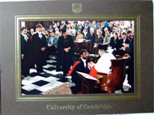
Abhijit
Guha
received his PhD degree in Engineering from Trinity College. He was
the
Prince of Wales Scholar (this
Scholarship for 3 years is given by
Trinity College to
the best candidate of all commonwealth countries out of all subject
disciplines). During this period he was also an
Honorary Nehru Scholar
(this scholarship is awarded by Nehru Trust to about 10 PhD students
from all over India in all disciplines). He later
became a
Senior Rouse Ball Scholar at Trinity College, which is
bestowed upon a
work which "has greatly impressed the Electors by its quality and
promise in an area of
research which is worthy of continued support". Trinity College is the
most famous of Cambridge colleges with
32 Nobel
Laureates
(up to 2009). As an example, Sir
Andrew Huxley, who was the Master of the college
during the first phase of Abhijit Guha's time at the college is a Nobel
Laureate. The college also has had similarly top-ranking
mathematicians. (There is no Nobel Prize in the field of
mathematics,
Fields Medal
is considered of the same stature -
for
example,
Sir
Michael Atiyah, who was the Master of the college during the second
phase of Abhijit
Guha's
time at the college, is a Fields Medalist. He also won the Abel Prize
in 2004.) Of the current Fellows of the College in 2011, there are
4 Nobel Prize
winners, 3 Fields Medalists, 37 FRS and 22 FBA's, additionally 3
Honorary Fellows are Nobel Laureates. King
Henry VIII founded the
college in 1546.
Issac Newton is
its most famous member on whose statue the following words are
inscribed "Qui genus humanum ingenio superavit".
James Clark Maxwell
(one of the greatest
theoretical physicists ever and the first Cavendish Professor),
Ernest
Rutherford (one of the greatest pioneers of subatomic physics),
GI
Taylor (the great fluid dynamicist famous for his statistical theory of
turbulence; he also proposed in 1934 the idea of dislocation in
crystals),
Alan Hodgkin and
Andrew Huxley (giving the physico-chemical
explanation of the transmission of nerve impulses),
Charles Babbage
(who built the forerunner of modern computers),
WH Fox Talbot (an
inventor of photography)
,
Ludwig Wittgenstein (one of the greatest philosophers of the 20th century writing
Tractatus
Logico-Philosophicus 1921 and
Philosophical Investigations
1953) are all "Trinity
Men", as are
Francis Bacon,
Alfred Tennyson,
Lord Byron,
Amartya
Sen,
Lord Rayleigh,
JJ Thomson,
William Bragg,
Niels Bohr,
Arthur Eddington,
Subramanyan
Chandrasekhar,
Alfred Whitehead,
Bertrand Russell,
John Littlewood,
Godfrey H Hardy and
Srinivasa Ramanujan.
GH Hardy, in his book
A
Mathematician's Apology (and CP Snow in its Foreword), has
immortalised the Trinity tradition in mathematics and the
Hardy-Ramanujan legend. The picture on the right is of the iconic
fountain which is in the middle of the Great Court which is the largest
court in Cambridge or Oxford. The challenge is to complete a
rectangular path surrounding the fountain as the college clock strikes
twelve (Film:
Chariots of Fire). The Nevile's Court is smaller in
dimension and is lined by
the Wren Library which was completed in 1695 to the design of Sir
Christopher Wren. The
library has many special collections including the Capell collection of
early
Shakespeare editions,
AA Milne's manuscripts of
Winnie-the-Pooh,
and many books from Sir
Issac Newton's own library including
preliminary manuscripts for Issac Newton's 1687
Principia, several
early editions of the book and the correspondence between
Issac Newton
and
Richard Bentley on
Principia. On the
roof of the Wren Library are four statues representing Divinity, Law,
Physics and Mathematics. The legend is that Newton determined the speed
of sound by measuring the time that a hand-clap took to reflect in a
corridor of the Nevile's Court. At the back of Trinity is the
magnificent The Avenue - the road through a continuous living arch
formed by two colonnades of lime and cherry trees on both sides - that
connects the New
Court to the Fellows Garden on the other side of Queen's Road, going
over the river Cam and through The Backs. On the other side of the
Fellows Garden there are student hostels including the Butler House on
Grange Road, in which A Guha resided during his first year at
Cambridge. The impressive main entrance to Trinity College, the
Great Gate, has a statue of
Henry VIII holding a ------ in his hand
(find out what when you next visit Trinity!).
Trinity
College website
BBC's
panoramic view of the Great Court

 After obtaining a PhD from Trinity College Cambridge and before joining
University of Bristol, Dr Abhijit
Guha spent
several years as a
After obtaining a PhD from Trinity College Cambridge and before joining
University of Bristol, Dr Abhijit
Guha spent
several years as a 
 Abhijit
Guha
received his PhD degree in Engineering from Trinity College. He was
the
Abhijit
Guha
received his PhD degree in Engineering from Trinity College. He was
the 












